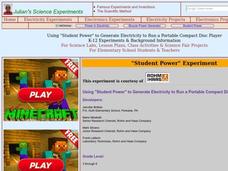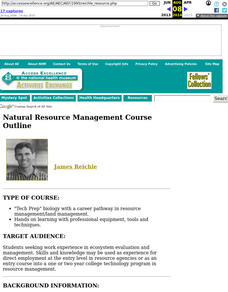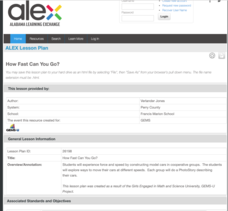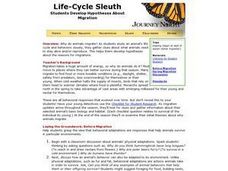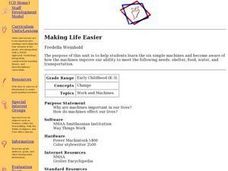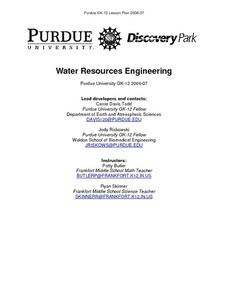Curated OER
Permeability (Magnetism)
High schoolers investigate magnetic permeability and saturation. For this physics lesson, students explain how current carrying wire coils create magnetic forces. They interpret normal magnetization curves.
Curated OER
Electromagnetic Bomb (E-Bomb)
Students explain how E-bomb works. In this physics lesson, students simulate the effects of e-bombs on electronic targets. They discuss its potential harmful effects when used as a weapon.
Curated OER
Using "Student Power" to Generate Electricity to Run a Portable Compact Disc Player
Students explain the relationship between magnetism and electricity. In this physics lesson, students describe the transformation of energy. They create an electromagnet and investigate the factors affecting its strength.
Curated OER
Electric Power Transmission and Distribution
Students explain how power is transmitted over long distances. In this physics lesson, students simulate controlling power flow in parallel transmission lines. They discuss several applications of wireless power transmission.
Curated OER
Disposable Diaper Comparison and Mystery Powder Identification
Students investigate which diaper is the most absorbent. In this chemistry lesson, students calculate how much water is absorbed by diapers. They identify an unknown powder based on physical and chemical properties.
Curated OER
Natural Resource Management Course Outline
Gain skills in ecosystem evaluation including chemical, biological, and physical qualities. Students write a report on a local ecosystem.
Curated OER
Properties of Minerals
Students research properties of minerals. In this science lesson, students search the web, create a folder, and store information on properties of minerals. There are many excellent worksheets and study guides embedded in this lesson,...
Curated OER
Somethin' Sweet
Students make their own candy. In this science lesson plan, students observe how molecules interact with each other in physical changes and observe how the addition of heat can cause molecules to interact and form new molecules in...
Alabama Learning Exchange
How Fast Can You Go?
Learners investigate force and speed. In this physics lesson plan, students construct model cars in small groups and perform experiments to identify what factors influence speed and force.
Curated OER
Genetic Mind Reader Review Game
Students review some important concepts and terms relevant to the Human Genome Project and genetic research. The game is played like a mind reading session between two teams.
Curated OER
Hatching Chickens
Students observe chicks hatching from eggs. In this science lesson plan, students view a video to develop an understanding of the proper care and needs of eggs and live animals. This is a great precursor activity for hatching eggs in class.
Curated OER
Life-Cycle Sleuth
Learners analyze an animal's life cycle and behaviors, and examine what animals need to stay alive and reproduce. They develop theories and hypotheses about the reasons for migrations, using the Journey North online project.
Curated OER
The Great Rock Sort
Students describe and sort rocks according to their physical properties. They listen to a story and discuss what they know about rocks, then work with a partner to discuss how their sample rocks differ from each other.
Curated OER
Thinking About Life in Geological Time Scales
Students create a large (classroom-sized) timeline showing the history of life on Earth for the last 5 billion years. They are able to identify the events that are relevant to their taxonomic projects (the Origins and important...
Curated OER
PRIMARY Activity: Racing Jars
Learners explore how mass affects speed in this hands-on physics experiment. For this mass and speed lesson, students fill a baby food jar with water and leave a second jar empty. They roll the 2 jars down a ramp to observe which jar...
Curated OER
Positive Feedback Opamp Circuits
In this physics worksheet, students complete 12 short answer questions on opamp circuits. They also perform calculations of voltage in some items.
Curated OER
Simple Machines: The Wede & Lever
Students describe how wedge and lever makes work easier. In this physics lesson, students analyze experimental data by creating a graph to see the trends. They calculate the work done and mechanical advantage of these simple machines.
Curated OER
Mendelian and Non-Mendelian Heredity
Tenth graders discuss their physical features, and why they look the way they do. They listen as the teacher discusses DNA, alleles, and dominant or recessive genes. Students perform an experiment with different colored markers...
Curated OER
Making Life Easier
Students use a chart of the six simple machines and become aware of how the machines improve our ability to meet the following needs: shelter, food, water, and transportation. Students use model cars to experiment with force. They divide...
Curated OER
Water Resources Engineering
Students illustrate the chemical differences between surface and tap-water. They investigate the common chemical and physical parameters relevant for water quality and gain hands on experience with water quality testing.
They enhance...
Curated OER
Layers of the Earth: Plate Tectonics
Sixth graders participate in a lesson that is about investigating the different layers of the earth and defining how the plates move over the mantle. They engage in a variety of activities and use mathematics to create projects to...
Curated OER
The Power of the Plug: How Electricity Will Change Our Lives... Again
Students study electricity. In this physics lesson, students review electrical energy by discussing three ways of generating it. Students explore various energy sources used for creating electricity and examine how different states...
Curated OER
Linear Motion
In this fantastic physics and math lesson, student pairs create a ramp that will transport a rolling marble in order to learn about linear motion. Students use cardboard, straws, toothpicks, marshmallows, and paper clips in order to make...
Curated OER
Classifying Conundrum
Fourth graders identify plant characteristics from different environments and communicate that information in different ways. They use a simple scheme to classify Utah plants and animals and make observations and record them in a...




